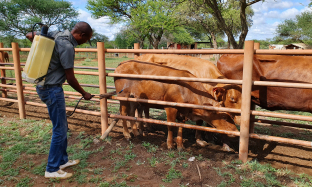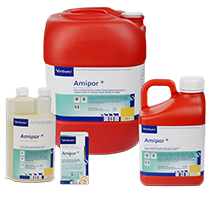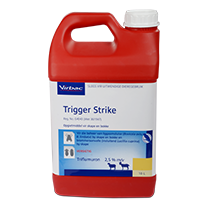
Red lice and the control in Sheep and Goats
Red Lice (Bovicola ovis, Bovocola limbata) is the most important lice species in sheep and goats. It has a major economic impact on wool, hair and meat production.
Lice spend their entire life cycle on sheep / goats and move constantly through the fleece. This free movement facilitates the transfer of lice from infected to non-infected animals. To complete their life cycle (from egg to an adult louse that lay eggs again) takes ± 29 days. A light lice infestation (± 5000 red lice) can become major problem within 2-3 months due to the short life cycle.
Autumn and winter months are the most favourable times for red lice to multiply, the reason being is that:
- Environmental conditions are more favourable due to a decrease in temperatures and humidity.
- In the winter months immunity levels reduce as result of poor food quality and / or quantity.
- Higher stocking densities make lice transmission from infected to lice-free animals easier in the herd.
- Wool length (long) is optimal, because of traditional spring and early summer shearing.
Lice cause:
- Irritation
- Skin damages and break in the wool
- Itching and scratching
- Flies are attracted by serum leaking from exposed areas which lead to blowfly strike
- Weight loss
The effect on wool production, clean yield and price (Joshua, 2001 NSW)
A light lice infestation cause:
- 3% reduction in wool production
- 1% reduction in clean yield of wool
- 2% reduction in the wool price
The total R-value loss per sheep with light lice infection is ± R19.50 (The value is calculated at R75 / kg wool, average 5kg of wool per sheep)
LICE CONTROL
The largest source of reinfection in sheep and goats are the remaining lice that were not effectively controlled by previous treatments.
- The best time to treat for lice depends on the control method that is selected i.e Pour-on or Dip / Spray (jetting).
- Lice feed on the skin surface so the product chosen must reach the skin surface to provide effective lice control.
- Wool length is also an important factor that must be taken into consideration with lice control. Control in sheep with long wool is mostly just an emergency treatment that offers relief and does not effectively control all the lice because it is difficult to get enough of the active ingredient onto the skin surface. For best results, animals should be sheared, and then treated for lice.
INSECT GROWTH REGULATORS:
Insect growth regulators (IGRs), such as Trigger Strike are used to reduce lice numbers. The product do not kill lice on contact, but prevent the development of immature lice present in the fleece during application as well as those that will hatch in the next 20 weeks.
POUR-ON'S
Pour-on’s (Amipor) are ready-to-use products that are applied with an applicator on the back in a broad band from between the ears to the tail. Regardless of the label claims, the best use for pour-on remedies is within 24 hours from shearing. This will distribute a higher concentration of the active ingredient all over the body in the lanolin layer and ensure the best control.
The advantage of pour-on remedies is that
- It is ready to use
- It is easy to treat
- Low capital outlay (no plunge dip tank required)
- Less stressful for animals
- Pregnant animals can be treated
- It can be applied directly after shearing.
- It is always at the correct concentration / strength
DIP REMEDIES
Dip remedies can be applied through plunge dipping, a spray race or 'jetting'. Sheep can only be dipped 3-4 weeks after shearing and up to ± 2 months before shearing.
Key factors for success with dipping is
- The right dip concentration.
- Preparing fresh dip tank replenishment regularly with clean water. (Keep dip tank water as clean as possible)
- Short wool length (1-3 months) produce the best results. With long wool it harder to get the right amount of active ingredient onto the skin.
6009230810CM



